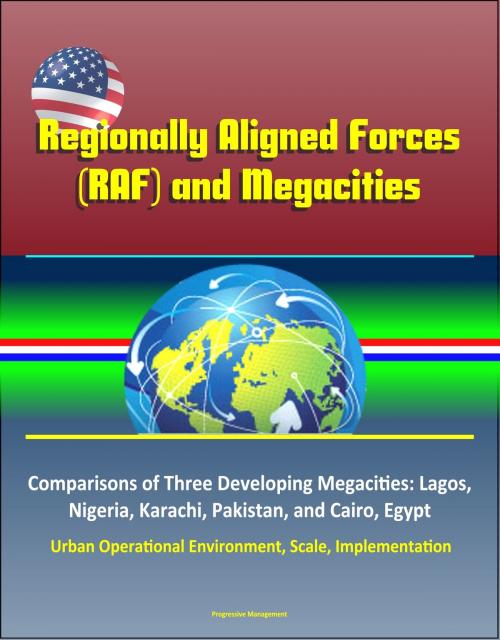Regionally Aligned Forces (RAF) and Megacities – Comparisons of Three Developing Megacities: Lagos, Nigeria, Karachi, Pakistan, and Cairo, Egypt – Urban Operational Environment, Scale, Implementation
Nonfiction, History, Military, United States| Author: | Progressive Management | ISBN: | 9781370404018 |
| Publisher: | Progressive Management | Publication: | March 3, 2017 |
| Imprint: | Smashwords Edition | Language: | English |
| Author: | Progressive Management |
| ISBN: | 9781370404018 |
| Publisher: | Progressive Management |
| Publication: | March 3, 2017 |
| Imprint: | Smashwords Edition |
| Language: | English |
This excellent report has been professionally converted for accurate flowing-text e-book format reproduction. Regionally Aligned Forces, while providing useful tactical capabilities like cultural and language familiarity, are inadequate for developing comprehensive information about megacity environments. Further, when megacities are considered as complex, adaptive systems, the limitations of comprehensive knowledge reveal themselves. Emergent events that have significant impact on the operational environment are plain only in hindsight, causally linked to the interactions between interdependent agents and populations in the city. Though RAF are not the primary solution to understanding megacities, they do represent the mindset of human engagement that will be required to discern the relationships between key actors in the environment. Gaps in professional knowledge of megacity environments could be addressed through officer education and fellowship programs, while tactical issues and technological development can be resolved in existing or accessible training sites. The method used is controlled comparison of three different developing megacity environments: Lagos, Karachi, and Cairo. These three environments readily demonstrate the complexity, scale, and depth of megacity environments and the challenges inherent in addressing them with Regionally Aligned Forces.
The consequences of globalization, industrialization, and urban migration have resulted in a relatively new phenomenon. Today, there are twenty-eight megacities globally - cities with a population in excess of ten million. Five more cities are currently on the cusp of breaking this arbitrary population metric. Megacities present several problems for the Army besides their sizeable populations. Two key traits that define the megacity environment are the scale of the environment and the density of the population therein. Scale in this case refers to the large geographic area of continuous urban landscape. The density of the population is the number of people living in a limited space, and the pressure that density exerts on the city as a whole as the population grows. In layman's terms, a megacity is "nothing more than a large city" where the cultures, religions, economies, and politics of the people who live there defines the individual character of the environment.
Current Army doctrine recognizes world urbanization trends and the importance of cities, providing a number of reasons for conducting decisive action within them. Enemy forces may choose to withdraw into the urban environment to mitigate Army and Joint Force advantages in firepower and maneuver. Aspects of the city in question may have operational or strategic value. The city may be of symbolic importance. Finally, the geographical location of the city may dominate a region or avenue of approach. The concentration of human capital, commerce, industry and governance in megacities serves to increase their importance.
This excellent report has been professionally converted for accurate flowing-text e-book format reproduction. Regionally Aligned Forces, while providing useful tactical capabilities like cultural and language familiarity, are inadequate for developing comprehensive information about megacity environments. Further, when megacities are considered as complex, adaptive systems, the limitations of comprehensive knowledge reveal themselves. Emergent events that have significant impact on the operational environment are plain only in hindsight, causally linked to the interactions between interdependent agents and populations in the city. Though RAF are not the primary solution to understanding megacities, they do represent the mindset of human engagement that will be required to discern the relationships between key actors in the environment. Gaps in professional knowledge of megacity environments could be addressed through officer education and fellowship programs, while tactical issues and technological development can be resolved in existing or accessible training sites. The method used is controlled comparison of three different developing megacity environments: Lagos, Karachi, and Cairo. These three environments readily demonstrate the complexity, scale, and depth of megacity environments and the challenges inherent in addressing them with Regionally Aligned Forces.
The consequences of globalization, industrialization, and urban migration have resulted in a relatively new phenomenon. Today, there are twenty-eight megacities globally - cities with a population in excess of ten million. Five more cities are currently on the cusp of breaking this arbitrary population metric. Megacities present several problems for the Army besides their sizeable populations. Two key traits that define the megacity environment are the scale of the environment and the density of the population therein. Scale in this case refers to the large geographic area of continuous urban landscape. The density of the population is the number of people living in a limited space, and the pressure that density exerts on the city as a whole as the population grows. In layman's terms, a megacity is "nothing more than a large city" where the cultures, religions, economies, and politics of the people who live there defines the individual character of the environment.
Current Army doctrine recognizes world urbanization trends and the importance of cities, providing a number of reasons for conducting decisive action within them. Enemy forces may choose to withdraw into the urban environment to mitigate Army and Joint Force advantages in firepower and maneuver. Aspects of the city in question may have operational or strategic value. The city may be of symbolic importance. Finally, the geographical location of the city may dominate a region or avenue of approach. The concentration of human capital, commerce, industry and governance in megacities serves to increase their importance.















